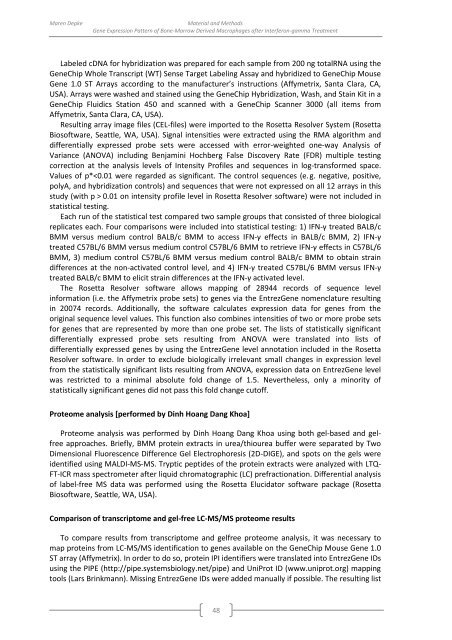genomewide characterization of host-pathogen interactions by ...
genomewide characterization of host-pathogen interactions by ...
genomewide characterization of host-pathogen interactions by ...
You also want an ePaper? Increase the reach of your titles
YUMPU automatically turns print PDFs into web optimized ePapers that Google loves.
Maren Depke<br />
Material and Methods<br />
Gene Expression Pattern <strong>of</strong> Bone-Marrow Derived Macrophages after Interferon-gamma Treatment<br />
Labeled cDNA for hybridization was prepared for each sample from 200 ng totalRNA using the<br />
GeneChip Whole Transcript (WT) Sense Target Labeling Assay and hybridized to GeneChip Mouse<br />
Gene 1.0 ST Arrays according to the manufacturer’s instructions (Affymetrix, Santa Clara, CA,<br />
USA). Arrays were washed and stained using the GeneChip Hybridization, Wash, and Stain Kit in a<br />
GeneChip Fluidics Station 450 and scanned with a GeneChip Scanner 3000 (all items from<br />
Affymetrix, Santa Clara, CA, USA).<br />
Resulting array image files (CEL-files) were imported to the Rosetta Resolver System (Rosetta<br />
Bios<strong>of</strong>tware, Seattle, WA, USA). Signal intensities were extracted using the RMA algorithm and<br />
differentially expressed probe sets were accessed with error-weighted one-way Analysis <strong>of</strong><br />
Variance (ANOVA) including Benjamini Hochberg False Discovery Rate (FDR) multiple testing<br />
correction at the analysis levels <strong>of</strong> Intensity Pr<strong>of</strong>iles and sequences in log-transformed space.<br />
Values <strong>of</strong> p* 0.01 on intensity pr<strong>of</strong>ile level in Rosetta Resolver s<strong>of</strong>tware) were not included in<br />
statistical testing.<br />
Each run <strong>of</strong> the statistical test compared two sample groups that consisted <strong>of</strong> three biological<br />
replicates each. Four comparisons were included into statistical testing: 1) IFN-γ treated BALB/c<br />
BMM versus medium control BALB/c BMM to access IFN-γ effects in BALB/c BMM, 2) IFN-γ<br />
treated C57BL/6 BMM versus medium control C57BL/6 BMM to retrieve IFN-γ effects in C57BL/6<br />
BMM, 3) medium control C57BL/6 BMM versus medium control BALB/c BMM to obtain strain<br />
differences at the non-activated control level, and 4) IFN-γ treated C57BL/6 BMM versus IFN-γ<br />
treated BALB/c BMM to elicit strain differences at the IFN-γ activated level.<br />
The Rosetta Resolver s<strong>of</strong>tware allows mapping <strong>of</strong> 28944 records <strong>of</strong> sequence level<br />
information (i.e. the Affymetrix probe sets) to genes via the EntrezGene nomenclature resulting<br />
in 20074 records. Additionally, the s<strong>of</strong>tware calculates expression data for genes from the<br />
original sequence level values. This function also combines intensities <strong>of</strong> two or more probe sets<br />
for genes that are represented <strong>by</strong> more than one probe set. The lists <strong>of</strong> statistically significant<br />
differentially expressed probe sets resulting from ANOVA were translated into lists <strong>of</strong><br />
differentially expressed genes <strong>by</strong> using the EntrezGene level annotation included in the Rosetta<br />
Resolver s<strong>of</strong>tware. In order to exclude biologically irrelevant small changes in expression level<br />
from the statistically significant lists resulting from ANOVA, expression data on EntrezGene level<br />
was restricted to a minimal absolute fold change <strong>of</strong> 1.5. Nevertheless, only a minority <strong>of</strong><br />
statistically significant genes did not pass this fold change cut<strong>of</strong>f.<br />
Proteome analysis [performed <strong>by</strong> Dinh Hoang Dang Khoa]<br />
Proteome analysis was performed <strong>by</strong> Dinh Hoang Dang Khoa using both gel-based and gelfree<br />
approaches. Briefly, BMM protein extracts in urea/thiourea buffer were separated <strong>by</strong> Two<br />
Dimensional Fluorescence Difference Gel Electrophoresis (2D-DIGE), and spots on the gels were<br />
identified using MALDI-MS-MS. Tryptic peptides <strong>of</strong> the protein extracts were analyzed with LTQ-<br />
FT-ICR mass spectrometer after liquid chromatographic (LC) prefractionation. Differential analysis<br />
<strong>of</strong> label-free MS data was performed using the Rosetta Elucidator s<strong>of</strong>tware package (Rosetta<br />
Bios<strong>of</strong>tware, Seattle, WA, USA).<br />
Comparison <strong>of</strong> transcriptome and gel-free LC-MS/MS proteome results<br />
To compare results from transcriptome and gelfree proteome analysis, it was necessary to<br />
map proteins from LC-MS/MS identification to genes available on the GeneChip Mouse Gene 1.0<br />
ST array (Affymetrix). In order to do so, protein IPI identifiers were translated into EntrezGene IDs<br />
using the PIPE (http://pipe.systemsbiology.net/pipe) and UniProt ID (www.uniprot.org) mapping<br />
tools (Lars Brinkmann). Missing EntrezGene IDs were added manually if possible. The resulting list<br />
48

















